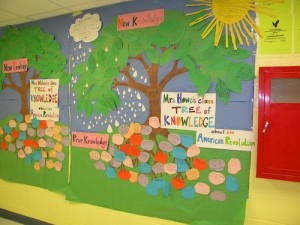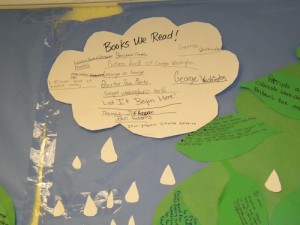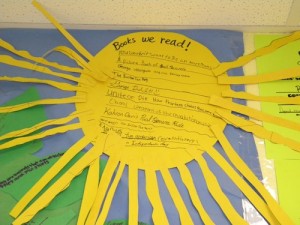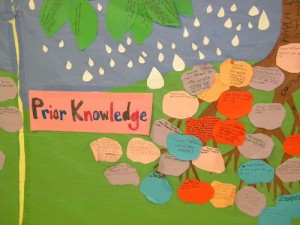By Lauren Freedman, Western Michigan University
 Children and teachers, mired in narrow curricula and “say this now” instruction geared toward raising achievement scores on standardized tests, are hungry for interesting, engaging, and filling content to be reading, writing, speaking, listening, thinking, and learning about. In a 5th grade Social Studies classroom, the students engaged in an inquiry built around the American Revolution and used a tree as a graphic depiction not only of what they were learning, but also as a metaphor for their learning process and the ways in which inquiry and text sets facilitate learning. Along with the content learning depicted in the photos, the students also engaged in a metacognitive discussion about the ways in which “…a reader is like a tree.” The students’ responses quoted below clearly demonstrate the growth possible when the literacy diets of our children are varied and nutritious.
Children and teachers, mired in narrow curricula and “say this now” instruction geared toward raising achievement scores on standardized tests, are hungry for interesting, engaging, and filling content to be reading, writing, speaking, listening, thinking, and learning about. In a 5th grade Social Studies classroom, the students engaged in an inquiry built around the American Revolution and used a tree as a graphic depiction not only of what they were learning, but also as a metaphor for their learning process and the ways in which inquiry and text sets facilitate learning. Along with the content learning depicted in the photos, the students also engaged in a metacognitive discussion about the ways in which “…a reader is like a tree.” The students’ responses quoted below clearly demonstrate the growth possible when the literacy diets of our children are varied and nutritious.
As suggested by the first student, without sun and rain (books), the tree (the reader) would wither.
 A reader is like a tree. The roots are like your prior knowledge. The trunk is your brain every time you learn new things you get smarter. Your leaves are new knowledge you learn things every time you read so you learn more things. Sun & rain are your books; they help you grow.
A reader is like a tree. The roots are like your prior knowledge. The trunk is your brain every time you learn new things you get smarter. Your leaves are new knowledge you learn things every time you read so you learn more things. Sun & rain are your books; they help you grow.…W.B.
The next student suggests that keeping track of knowing what we know helps us to learn more and grow smarter.
 When I read it’s like my brain is getting bigger and I am getting smarter. It’s like I’m a tree (or my brain) and it grows everyday. The trunk keeps the knowledge – everything I know. The roots are my prior knowledge before what I know now. Books I read help me grow from head to toe. New knowledge helps me understand what I already know.
When I read it’s like my brain is getting bigger and I am getting smarter. It’s like I’m a tree (or my brain) and it grows everyday. The trunk keeps the knowledge – everything I know. The roots are my prior knowledge before what I know now. Books I read help me grow from head to toe. New knowledge helps me understand what I already know.…C.C.
The next student speaks to the role of making connections between what we know and what we are learning.
 When you read some of the stuff you know will still be there which helps you to keep t he information in your brain. When you read, you learn new things and that’s when your leaves grow which is the new knowledge. When you have read a book (the sun) , it goes to your prior knowledge and grows in your brain.
When you read some of the stuff you know will still be there which helps you to keep t he information in your brain. When you read, you learn new things and that’s when your leaves grow which is the new knowledge. When you have read a book (the sun) , it goes to your prior knowledge and grows in your brain.The problem is that there is an enormous disconnect between what children and many, many teachers know about how children learn and the current decision-makers who think learning is mechanical rather than biological. While the federal department of education, too many state departments of education, too many local school districts and individual schools are busy buying teacher-proofed, one-size-fits-all-students curricular materials, there has been and continues to be a growing body of research that supports the value and learning-focused benefits of providing children with an inquiry framework and multiple trade books that afford them choices and opportunities to become increasingly more independent, confident, and metacogitive learners (Johnson, Freedman, Thomas, 2008).
The National Research Council (as cited in, Ebbers, 2002) suggests that inquiry in science classrooms is not all hands-on, rather it incorporates, “…examining books and other sources of information to see what is already known; and planning investigations, proposing answers, explanations, and predictions; and communicating the results” (p.40).
In their article, “Choosing and Using Information Trade Books, “ Saul and Dieckman (2005), suggest that, “Although literacy might be improved by building experiential background knowledge, an understanding of content can also be improved through exposure to text” (p. 508508). They further provide reading strategies that are deepened through use of content trade books:
•Use existing knowledge to make sense of text;
•Ask questions before, during, and after reading;
•create images of or visualize what they read;
•determine what’s important in the text they read;
•monitor comprehension throughout the reading process;
•repair comprehension once reader realized it’s gone awry;
•draw inferences during and after reading;
•synthesize information while they read.(p. 508)
Building a text set is relatively easy as there are now numerous databases that can assist you, not the least of which is the WOW database. I have used it with the middle school teachers I work with to build sets that deal with Eastern Hemisphere geography for example. Most public librarians are more than willing to help teachers build sets and most of the libraries allow teachers to check out up to 50 books at a time. Scholastic is an obvious venue for these materials especially the warehouse sales that happen in almost every city in every state. Also web sites for on-line booksellers such as Amazon and Barnes and Noble are great for seeing what’s out there. It is important to remember that all text sets whether for grades k-1 or 12 should include both picture books and chapter books as the range of readers and the background and interest they bring to the content varies widely and there needs to be plenty of material that will both guarantee success and challenge so that as many school mottos say, “EVERY CHILD LEARNS EVERY DAY.”
References
Ebbers, M. (2002). Science text sets: Using various genres to promote literacy and inquiry. Language Arts, 80(1), pp. 40-50.
Johnson, H., Freedman, L., & Thomas, K. F. (2008). Building reading confidence in adolescents: Key elements that enhance proficiency. Thousand Oaks, CA:
Corwin Press.
Saul, E. W. & Dieckman, D. (2005). Choosing and using information trade books. Reading Research Quarterly, 40(4), pp. 502-513.
Journey through Worlds of Words during our open reading hours: Monday-Friday, 9 a.m. to 5 p.m. and Saturday, 9 a.m. to 1 p.m. To view our complete offerings of WOW Currents, please visit archival stream.
- Themes: Lauren Freedman, text sets
- Descriptors: Student Connections, WOW Currents

Using the tree as a visual for the students to organize their prior knowledge and new learning is a great way for connecting and growing in the topic as well as understanding how the new learning happens!